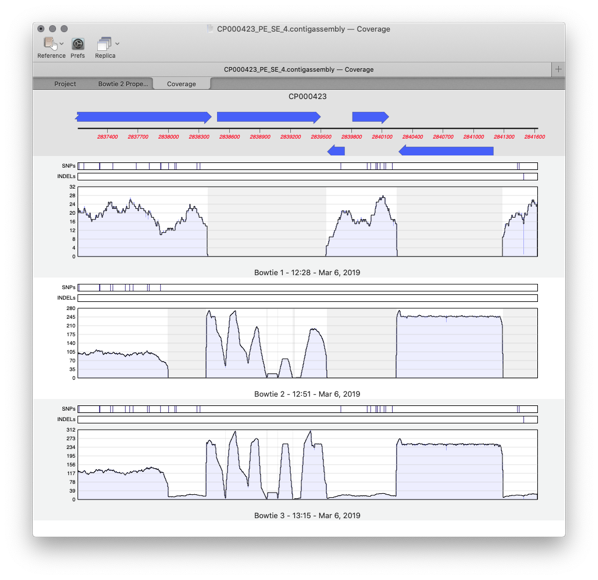Tag: assembler
-
101 things you (maybe) didn’t know about MacVector: #52 – Data mining to identify and analyze pangolin CoV-2 analogs to the human COVID-19 virus
One of the most underrated features in MacVector is the Database | Align to Folder function. You can use this as a more sensitive version of a local BLAST search to find sequences in a “database” that match a query sequence. But in this case the “database” is simply a collection of your own sequences,…
-
Importing BAM files into an Assembly Project
You can import BAM files, containing reads mapped against a reference sequence, into a MacVector Assembly Project. As well as the BAM file(s) you will also need the original reference sequence the reads were mapped against. FASTA is fine, but an annotated reference is better for visualisation. The tool needed is called ADD CONTIG. This…
-

Gap closing and genome finishing tools in Align to Reference and Assembler.
Automated algorithms can only take you so far with genome assembly. The final steps involved in finishing a genome always need manual intervention. MacVector’s various assembly editors have many tools for helping finish genome sequencing projects. For example, closing gaps, extending reference sequences and even automatically circularizing contigs. If you select reads, then right click…
-
Identifying transposon insertion sites from multiplexed NGS data
Transposon mutagenesis is a common approach for investigating gene function in bacterial genomes by selecting for clones where the transposon inserting into the genome has generated a specific phenotype. You can then simply sequence the entire genome of each clone by NGS to identify the transposon insertion site. To lower the cost of such experiments,…
-
Human Transcriptome RNA-Seq Analysis Using MacVector
With MacVector Pro and Assembler you can use Bowtie to perform RNA-Seq analyses using NGS data. The interface even has specialized output tabs listing the coverage information and statistics for each annotated CDS and gene feature on the genome. You can download a short tutorial and a sample dataset that illustrate the analysis workflow using…
-
Use a right-click in the Editor tab to see if your contig can be circularized
MacVector incorporates no less than THREE different de novo assemblers, phrap, velvet and SPAdes. While all are great assemblers, with each having their own specific advantages, none of them will generate a circular sequence from input reads. However, MacVector also includes a tool to help you with this. If you are assembling reads representing plasmid…
-
Import Multi-Sequence Genbank Files into an Assembly Project for easy access to Features
There are many genomes in the Genbank database that cannot be downloaded as single annotated sequences. These might be large multi-chromosome eukaryotic genomes, but, increasingly, partially sequenced bacterial chromosomes where the major contigs have been annotated using the NCBI annotation pipeline. Typically, when you encounter these, there are options to download annotated versions of these…
-
Optimizing Align To Folder Parameters for use with NGS Data
You can use the Database | Align To Folder function to scan large fasta or fastq files containing NGS data to find and retrieve just those reads that match a specific target sequence. The search is aware of paired-end reads, so when you retrieve hits, both reads of a pair will be saved into a…
-
What can MacVector do for my lab?
Here’s what MacVector can do for your lab. Comparing sequences Whatever type of alignment your sequence needs, there’s a tool in MacVector. CRISPR Indel Analysis: Identify insertions and deletions following CRISPR editing of a target. Compare Genomes: Compares two related annotated genomes to identify identical, similar and weakly similar features. Sequence assembly of NGS data…
-

Comparing multiple reference assemblies
MacVector 17 has a greatly improved Assembly Projects manager, for better organization of multiple sequencing datasets, multiple references sequences and repeated jobs. Every time you run a new assembly job (either a reference assembly or de novo). A new job object is created in the Assembly Project window contains resulting contigs and any unaligned reads…
